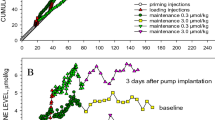Abstract
Sultopride and sulpiride are both chemically similar benzamide derivatives and selective antagonists of dopamine D2 receptors. However, these drugs differ in clinical properties. We compared the effects of sultopride and sulpiride on dopamine turnover in rats following the administration of these drugs alone or in combination with apomorphine. The administration of sultopride or sulpiride markedly accelerated dopamine turnover in the rat brain. The increase in the level of dopamine metabolites in the striatum was more marked in the sultopride-treated rats. Sulpiride affected the limbic dopamine receptors preferentially, whereas sultopride affected the striatal and the limoic dopamine receptors equally. A low dose of apomorphine induced a reduction in the concentration of dopamine metabolites in the striatum and the nucleus accumbens by approximately 55%, but not in the medial prefrontal cortex. Sultopride was more effective in preventing an apomorphine-induced reduction in dopamine metabolite levels. These results from rat experiments would model the pharmacological differences observed between sultopride and sulpiride in clinical use.
Similar content being viewed by others
References
Delay, J., Deniker, P., and Harl, J.-M. 1952. Traitement des etats d'excitation et d'agitation par une methode medicamenteuse derivee de I'hibernotherapie. Ann. Med.-Psychol. 110 (pt.2):267–273.
Carlsson, A., and Lindqvist, M. 1963. Effect of chlorpromazine or haloperidol on formation of 3-methoxytyramine and normetanephrine in mouse brain. Acta. Pharmacol. Toxicol. 20:140–144.
Giros, B., Sokoloff, P., Martres, M. P., Riou, J. F., Emorine, L. J., and Schwartz, J. C. 1989. Alternative splicing directs the expression of two D2 dopamine receptor isoforms. Nature 342:923–926.
Jenner, P., and Marsden, C. D. 1979. Minireview: The substituted benzamides — a novel class of dopamine antagonists. Life Sci. 25:479–486.
Kebabian, J. W., and Calne, D. B. 1979. Multiple receptors for dopamine. Nature 277:93–96.
Jenner, P., Elliott, P. N. C., Clow, A., Reavill, C., and Marsden, C. D. 1978. A comparison of in vitro and in vivo dopamine receptor antagonism produced by substituted benzamide drugs. J. Pharm. Pharmacol. 30:46–48.
Edwards, J. G., Alexander, J. R., Alexander, M. S., Gordon, A., and Zuchti, T. 1980. Controlled trial of sulpiride in chronic schizophrenic patients. Br. J. Psychiat. 137:522–529.
Kawamura, J., Fukuyama, H., and Matsubayashi, K. 1979. Clinical improvement of L-dopa-induced oral dyskinesias with sulpiride. Neurol. Med. 11:444–447. (in Japanese).
Kobayashi, K., Imazu, Y., Sakurai, H., Kawabata, M., and Shohmori, T. 1985. Effect of sulpiride on levodopa-induced dyskinesias. Neurosciences (Kobe) 11:309–314.
Jenner, P., and Marsden, C. D. 1979. The mechanism of action of substituted benzamide drugs. pages 119–147, In: Spano, P. F., Trabucchi, M., Corsini, G. U., and Gessa, G. L. (eds.), Sulpiride and other benzamides. Raven Press, New York.
Paxinos, G., and Watson, C. 1982. The rat brain in stereotaxic coordinates. Academic Press, New York.
Westerink, B. H. C., and Korf, J. 1977. Rapid concurrent automated fluorimetric assay of noradrenaline, dopamine, 3,4-dihydroxyphenylacetic acid, homovanillic acid and 3-methoxytyramine in milligram amounts of nervous tissue after isolation on Sephadex G10. J. Neurochem. 29:697–706.
Lowry, O. H., Rosebrough, N. J., Farr, A. L., and Randall, R. J. 1951. Protein measurement with the Folin phenol reagent. J. Biol. Chem. 193:265–275.
Nowycky, M. C., and Roth, R. H. 1978. Dopaminergic neurons: role of presynaptic receptors in the regulation of transmitter biosynthesis. Prog. Neuro-Psychopharmac. 2:139–158.
Westfall, T. C., Besson, M.-J., Giorguieff, M.-F., and Glowinski, J. 1976. The role of presynaptic receptors in the release and synthesis of3H-dopamine by slices of rat striatum. Naunyn-Schmiedeberg's Arch. Pharmacol. 292:279–287.
Roth, R. H. 1979. Dopamine autoreceptors: pharmacology, function and comparison with post-synaptic dopamine receptors. Commun. Psychopharmacol. 3:429–445.
Skirboll, L. R., Grace, A. A., and Bunney, B. S. 1979. Dopamine auto- and postsynaptic receptors: electrophysiological evidence for differential sensitivity to dopamine agonists. Science 206:80–82.
Di Chiara, G., Porceddu, M. L., Vargiu, L., Argiolas, A., and Gessa, G. L. 1976. Evidence for dopamine receptors mediating sedation in the mouse brain. Nature 264:564–567.
Hasan, F., and Leonard, B. E. 1981. Studies on the action of (±)sulpiride on dopamine receptors in the rat brain in vivo. Neuropharmacology 20:1327–1330.
Bannon, M. J., Michaud, R. L., and Roth, R. H., 1981. Mesocortical dopamine neurons lack of autoreceptors modulating dopamine synthesis. Mol. Pharmacol. 19:270–275.
Walters, J. R., and Roth, R. H. 1976. Dopaminergic neurons: an in vivo system for measuring drug interactions with presynaptic receptors. Naunyn-Schmiedeberg's Arch. Pharmacol. 296:5–14.
Ålander, T., Andén, N.-E., and Grabowska-Andén, M. 1980. Metoclopramide and sulpiride as selective blocking agents of pre-and postsynaptic dopamine receptors. Naunyn-Schmiedenberg's Arch. Pharmacol. 312:145–150.
Roth, R. H., Bacopoulos, N. G., Bustos, G., and Redmond, Jr. D. E. 1980. Antipsychotic drugs: differential effects on dopamine neurons in basal ganglia and mesocortex following chronic administration in human and nonhuman primates. pages 513–520,in Cattabeni et al. (eds.), Long-term effects of neuroleptics. Raven Press, New York.
Bartholini, G. 1976. Differential effect of neuroleptic drugs on dopamine turnover in the extrapyramidal and limbic system. J. Pharm. Pharmacol. 28:429–433.
Bischoff, S. 1992. Limbic selective neuroleptics. Clin. Neuropharm. 15(Suppl. 1, Pt.A):265–266.
Mizuchi, A., Kitagawa, N., and Miyachi, Y. 1983. Regional distribution of sultopride and sulpiride in rat brain measured by radioimmunoassay. Psychopharmacology 81:195–198.
Sokoloff, P., Giros, B., Martres, M. P., Bouthenet, M. L., and Schwartz, J. C. 1990. Molecular cloning and characterization of a novel dopamine receptor (D3) as a target for neuroleptics. Nature 347:146–151.
Author information
Authors and Affiliations
Rights and permissions
About this article
Cite this article
Moriuchi, K., Imazu, Y. & Yoneda, H. Differences in effects of sultopride and sulpiride on dopamine turnover in rat brain. Neurochem Res 20, 95–99 (1995). https://doi.org/10.1007/BF00995158
Accepted:
Issue Date:
DOI: https://doi.org/10.1007/BF00995158




